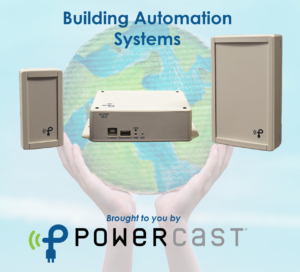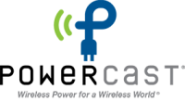Powercast’s Matter-Compliant, Wireless Smart Home Sensor Technology Powered Perpetually Over the Air
Powercast is happy to unveil a new technology solution, named a finalist in the Best of Sensors Awards program, for creating, deploying and perpetually powering sustainable, untethered, Matter-compliant wireless smart home  automation sensors. These sensors: 1) integrate into smart home ecosystems (Google Home, Amazon Alexa, Samsung SmartThings) using Matter, 2) easily install anywhere, 3) eliminate the need for expensive home wiring, 4) won’t require inconvenient, expensive battery maintenance, and 5) keep toxic disposable batteries out of landfills.
automation sensors. These sensors: 1) integrate into smart home ecosystems (Google Home, Amazon Alexa, Samsung SmartThings) using Matter, 2) easily install anywhere, 3) eliminate the need for expensive home wiring, 4) won’t require inconvenient, expensive battery maintenance, and 5) keep toxic disposable batteries out of landfills.
Powercast’s Wireless Smart Home Automation Sensor solution is perpetually powered by the company’s RF (Radio Frequency) over-the-air (OTA) wireless charging technology. To enable either battery-free or rechargeable-battery-based sensors to power themselves over the air from nearby RF transmitters, manufacturers will embed Powercast’s tiny Powerharvester® PCC110 wireless RF receiver chip and a small antenna into their sensors for around $1 at volume, then use a rechargeable battery or no battery at all.
 One RF transmitter in a room can power sensors installed up to 25 feet away, so placing one transmitter in each room will create a wireless power network able to perpetually power all the RF-enabled sensors throughout the home. There are also options for RF transmitters, including a licensable reference design that lets manufacturers integrate the electronics needed to convert their household products into RFID RF transmitters for only $5 bill-of-material (BOM) cost.
One RF transmitter in a room can power sensors installed up to 25 feet away, so placing one transmitter in each room will create a wireless power network able to perpetually power all the RF-enabled sensors throughout the home. There are also options for RF transmitters, including a licensable reference design that lets manufacturers integrate the electronics needed to convert their household products into RFID RF transmitters for only $5 bill-of-material (BOM) cost.
Check out the video on our newest technology: https://www.youtube.com
Powercast Joins RAIN Alliance Sustainability Working Group, Explains RF Wireless Power’s Role in Sustainable RAIN RFID Systems
Powercast Corporation, the industry’s one-stop-shop for wireless power, announced it has joined RAIN RFID Alliance’s Sustainability Working Group. This group’s goal is to provide education  onhow RAIN RFID technology, already used worldwide for the item tracking necessary in inventory management, stock control, logistics, retail and other applications, can also be an enabler for companies to achieve their sustainability objectives.
onhow RAIN RFID technology, already used worldwide for the item tracking necessary in inventory management, stock control, logistics, retail and other applications, can also be an enabler for companies to achieve their sustainability objectives.
What is RAIN RFID? RAIN Radio Frequency Identification (RFID) is a wireless technology that uses both handheld and fixed ultra-high frequency (UHF) RFID inventory readers that are prevalent in industries around the globe to connect billions of everyday items to the internet. It enables businesses and consumers to identify, locate, authenticate and engage each item bearing an RFID tag or label.
The Sustainability Working Group just published a report, “Bridging the Gap – Connecting Corporate Sustainability with RAIN RFID,” based on a 20-company survey of apparel, automotive, healthcare and other companies. Findings include:
- Data collected in existing RFID applications can also inform sustainability strategies, and there is evidence this is happening, but more education is needed to bridge RFID systems and sustainability efforts.
- Many examples of how RFID can help address sustainability challenges already exist, including: 1) achieving inventory accuracy levels that reduce waste and keep excess goods out of landfills, 2) being able to anticipate the lifespan of a product to facilitate recycling and waste management, and 3) collecting environmental data related to CO2 reduction.
“Powercast is committed to initiatives furthering a brighter sustainable future for generations to come, so we’re excited to join like-minded companies in RAIN’s Sustainability Working Group,” said Charles Greene, Ph.D., COO and CTO of Powercast. “Since 2007, our wireless power technologies have enabled untethered devices that need no battery maintenance and reduce the e-waste – cables, cords and disposable batteries – that litters landfills.”
Charles Goetz, CEO of Powercast, will explain wireless power’s role in sustainable RAIN RFID systems at the Connections Summit 2024, organized by RAIN RFID Alliance and NFC Forum, in Taichung, Taiwan, from May 13th to 16th.
“Combining RAIN’s identification and communication capabilities with Powercast’s radio frequency (RF) to direct current (DC) conversion technology can create smart, sustainable, maintenance-free device ecosystems able to both recharge and communicate over the air without wires or disposable batteries,” continued Greene.
How Powercast’s Wireless RF Power Technology Combines with RAIN RFID to Add Functionality:
Since UHF RFID readers emit an RF signal that’s similar to that of Powercast’s RF wireless power transmitters, these readers can be a reliable source of wireless power. Powercast’s tiny Powerharvester® PCC110 receiver chip embedded in RFID tags or labels can harvest RF and data sent over the air from any RFID reader – whether it’s fixed infrastructure or a handheld reader used by employees – and convert that RF to usable DC to both power devices and communicate data. Range depends on power consumption level; most devices can function up to 20 feet from a reader, while ultra-low-power devices can work up to 120 feet away. Devices can either be batteryless or rechargeable-battery-based, which eliminates inconvenient and expensive battery replacement efforts and keeps disposable batteries out of landfills.
As examples, a Powerharvester embedded in an electronic paper display (EPD) tag such as a retail electronic shelf-edge label (ESL), or an environmental sensing or logistics tag can harvest RF when it comes within range of a UHF RFID reader.
Several EPD applications were recently developed using partner E Ink’s bi-stable digital ePaper screen that can maintain an image perpetually, without a constant power source, until another over-the-air wireless update is sent. These EPDs include a wireless electronic bag tag, which harvests RF from airport RFID equipment to refresh the passenger’s itinerary on the screen; and Powercast’s own batteryless ESL which enables over-the-air retail price updates.
Other RFID over-the-air wireless power applications include environmental monitoring, such as Powercast’s RFID Sensor Tags which measure temperature, light and humidity; logistics and advanced location tracking devices; and sensing devices on products such as tires.
Powercast’s Energy-Saving, Sustainable Building Automation Technology Receives Smart Buildings Innovation Award
 The Wireless 25-Year Maintenance-Free Building Automation Sensor and Controller Technology for HVAC, Lighting Saves Substantial Energy, Costs 40% Less than Wired Systems, Eliminates Battery Maintenance and Reduces Battery E-Waste
The Wireless 25-Year Maintenance-Free Building Automation Sensor and Controller Technology for HVAC, Lighting Saves Substantial Energy, Costs 40% Less than Wired Systems, Eliminates Battery Maintenance and Reduces Battery E-Waste
Powercast announced that its Wireless 25-Year Maintenance-Free Building Automation Sensor and Controller Technology for HVAC and Lighting Systems has received an IoT Evolution Smart Buildings Innovation Award from IoT Evolution World. These awards acknowledge the companies behind the innovations transforming the way we design, construct, operate, and inhabit buildings.
Powercast’s sustainable building automation technology features revolutionary Lifetime Power® battery-powered sensors that last 25 years to provide wireless, maintenance-free, advanced HVAC and lighting control:
- The wirelessly-controllable lighting technology achieves substantial energy savings because it can harvest and efficiently use daylight energy, auto dim, and turn off lights when motion sensors detect no occupants.
- The HVAC system monitors environmental conditions including temperature, humidity, light, C02, differential pressure, contact closure, and more.
Such advanced environmental monitoring allows companies to embrace green initiatives, achieve LEED certification, adhere to regulatory requirements, and achieve significant cost savings through automation which can uncover patterns and insights to further optimize energy efficiency and identify potential issues before they arise.
“In an industry where most Building Automation Systems’ (BAS) batteries last 7-10 years, Powercast’s battery-powered sensors instead last 25 years for a lifetime sensing and environmentally-friendly solution, eliminating both the hassle and expense of battery maintenance, and reducing disposable battery e-waste that also keeps toxins out of landfills,” said Charles Greene, PhD, COO and CTO of Powercast.
Additional savings come from the wirelessly-powered sensors themselves. Companies don’t have to plan for building wiring or pay electrical labor to run wires. Without wires or battery maintenance, users can install more sensors to increase data for optimizing energy savings and comfort.
“We estimate our wirelessly-powered sensor system can save users 40%-50% over the installed cost of wired sensor and controller building automation systems, while also making a positive impact on the environment,” continued Greene. “The system is simple, intuitive and effective.”
“It is my pleasure to recognize the 25-Year Maintenance-Free Building Automation Sensor and Controller Technology for HVAC and Lighting Systems, an innovative solution that earned Powercast an IoT Evolution Smart Buildings Innovation Award,” said Rich Tehrani, CEO, TMC (co-publishers of IoT Evolution).
Powercast developed these systems both independently and in collaboration with partners, and they are covered by over 50 patents. The Powercast Lifetime Power technology is available through partnership to develop similar or new innovative products that create smart wireless solutions for sustainable applications.

